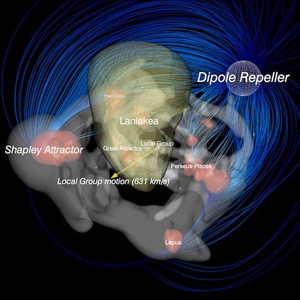The Dipole Repeller from Daniel Pomarède on Vimeo.
For decades, astronomers have known that our Milky Way galaxy—along with our companion galaxy, Andromeda—is moving through space at about 1.4 million miles per hour with respect to the expanding universe. Scientists generally assumed that dense regions of the universe, populated with an excess of galaxies, are pulling us in the same way that gravity made Newton’s apple fall toward earth.
In a groundbreaking study published in Nature Astronomy, a team of researchers, including Brent Tully from the University of Hawaiʻi Institute for Astronomy, reports the discovery of a previously unknown, nearly empty region in our extragalactic neighborhood. Largely devoid of galaxies, this void exerts a repelling force, pushing our Local Group of galaxies through space.
Astronomers initially attributed the Milky Way’s motion to the Great Attractor, a region of a half-dozen rich clusters of galaxies 150 million light-years away. Soon after, attention was drawn to a much larger structure called the Shapley Concentration, located 600 million light-years away, in the same direction as the Great Attractor. However, there has been ongoing debate about the relative importance of these two attractors and whether they suffice to explain our motion.
The newly discovered void was previously suggested by astronomers at the University of Hawaiʻi, but obtaining observational confirmation of the absence of galaxies has proved challenging. Until now, studies mostly focused on the detailed distribution of galaxies—where are galaxies located, and how much pull do they exert on the Milky Way? In this new study, the team, lead by Yehuda Hoffman, at the Hebrew University’s Racah Institutes of Physics, working with colleagues in the U.S. and France, tried a different approach. Instead of looking at the positions of galaxies, they used the galaxy motions instead. The team created a three-dimensional map of the galaxy flow field, and used this to infer the underlying mass distribution that consists of dark matter and luminous galaxies. This method reveals the overdense regions that pull on the Milky Way—and the underdense ones that push it.

The region of space that is moving coherently away from the void and toward attractors is huge, extending across more than a billion light years, or a tenth of the radius of the observable universe. The Laniakea supercluster of galaxies identified by the same team, and described in a 2014 Nature article, is embedded within this flow, like a cork in a stream.
“Through 3D mapping the flow of galaxies through space, we found that our Milky Way galaxy is speeding away from a large, previously unidentified, region of low density that we call the Dipole Repeller, as well as towards the known Shapley Concentration,” said Hoffman. “It has become apparent that push and pull are of comparable importance at our location.”
“There was a hint of the void from studies of the distribution of rich clusters of galaxies that emit X-rays, discussed in articles over a decade ago by Dale Kocevski, Harald Ebeling and myself at the University of Hawaiʻi”, said Tully, “but the statistics were not sufficient to be convincing.”
By identifying the Dipole Repeller, the researchers were able to explain both the direction of the Milky Way’s motion and its velocity relative to the rest of the Universe. They expect that future ultra-sensitive surveys at optical, near-infrared and radio wavelengths will directly identify the few galaxies expected to lie in this void, and directly confirm the void associated with the Dipole Repeller.
The work appears in the January 30 issue of Nature Astronomy and can be found online here.
The team of researchers includes Yehuda Hoffman, Hebrew University’s Racah Institute of Physics, Daniel Pomarède, Institut de Recherche sur les Lois Fondamentales de l’Univers, CEA, Université Paris-Saclay, Gif-sur-Yvette, France; R. Brent Tully, Institute for Astronomy, University of Hawaiʻi, U.S.; and Hélène M. Courtois, University of Lyon 1, France.
Additional images, video, and links to previous related productions can be found at http://irfu.cea.fr/dipolerepeller.
—By Roy Gal

